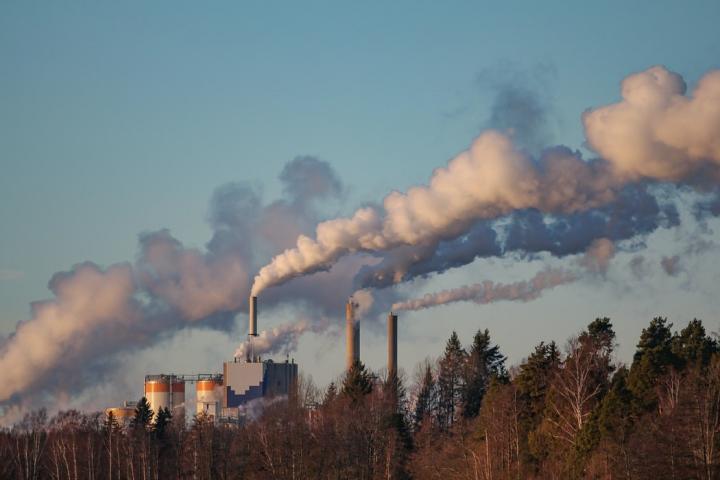Scientists demonstrate ground-level ozone concentrations have risen alongside the increasingly frequent spells of dry tropical weather

Credit: Daniel Moqvist on Unsplash
While ozone in the stratosphere acts as barrier that protects the Earth from ultraviolet radiation, ground-level (or tropospheric) ozone is a dangerous trace gas that can cause serious health problems. This ozone is the result of photochemical reactions between nitrogen oxides and volatile organic compounds, which are two major air pollutants.
Over the past decades, East Asia has witnessed a marked degradation of air quality, especially so in terms of ground-level ozone, that is consistent with human activity. However, in Korea, the specific reasons behind increase in ozone levels during warm seasons remain a mystery among atmospheric scientists.
To shed light on this issue, a team of scientists, including Prof Jin-Ho Yoon from Gwangju Institute of Science and Technology, Korea, recently conducted a study that was published in Atmospheric Environment. They focused on the relationship between large-scale weather patterns (called synoptic-scale weather) and surface ozone concentration. To do this, they used synoptic weather data from 17 airport meteorological stations and hourly observations of ground-level ozone concentrations from 306 monitoring sites.
One of the main findings of the study was that a particular synoptic weather pattern called ‘dry tropical’ was consistently associated with high ozone concentration. This is because ozone formation requires sunlight–which implies that dry and warm atmospheric conditions are favorable for its formation.
Most importantly, the researchers found that dry tropical weather had steadily become more frequent in Korea over the past 50 years, which is consistent with the gradual increase in tropospheric ozone levels. “We estimate that tropospheric ozone concentration could increase by 3.5% if the frequency of dry tropical weather doubles, and by an alarming 7.5% if it triples,” comments Prof. Yoon. “Our results imply that future air quality regulations in Korea should be issued together with those related to global and regional warming,” he adds.
Overall, this study provides valuable insights to tackle the long-standing mystery of tropospheric ozone in Korea. Lead author Dr. Hyun Cheol Kim from the National Oceanic and Atmospheric Administration and the University of Maryland, USA, remarks: “Understanding the relationship between synoptic weather patterns and surface ozone concentration will help us assess the contribution of meteorological conditions to regional air quality and establish an effective early warning system.” Let us hope this study brings more attention to the serious and interlinked issues of air pollution and climate change so that decisionmakers can act in time.
###
Reference
Authors: Hyun Cheol Kim (1,2), Dasom Lee (3), Fong Ngan (1,2), Byeong-Uk Kim (4), Soontae Kim (5), Changhan Bae (6), Jin-Ho Yoon (3)
Title of original paper: Synoptic weather and surface ozone concentration in South Korea
Journal: Atmospheric Environment
DOI: 10.1016/j.atmosenv.2020.117985
Affiliations:
- Air Resources Laboratory, National Oceanic and Atmospheric Administration
- Cooperative Institute for Satellite Earth System Studies, University of Maryland
- School of Earth Sciences and Environmental Engineering, Gwangju Institute of Science and Technology
- Georgia Environmental Protection Division
- Department of Environmental and Safety Engineering, Ajou University, Suwon
- National Air Emission Inventory and Research Center
About Gwangju Institute of Science and Technology (GIST)
Gwangju Institute of Science and Technology (GIST) is a research-oriented university situated in Gwangju, South Korea. One of the most prestigious schools in South Korea, it was founded in 1993. The university aims to create a strong research environment to spur advancements in science and technology and to promote collaboration between foreign and domestic research programs. With its motto, “A Proud Creator of Future Science and Technology,” the university has consistently received one of the highest university rankings in Korea.
Website: http://www.
About the authors
Dr. Hyun Cheol Kim is a Research Associate and Faculty Specialist of the Cooperative Institute for Climate and Satellites (CICS) at the University of Maryland, College Park, on an assignment for the NOAA/Air Resources Laboratory. In 2005, he received a PhD in Atmospheric Sciences from the University of Maryland, College Park.
Prof. Jin-Ho Yoon is an Associate Professor at the School of Earth Sciences and Environmental Engineering at the Gwangju Institute of Science and Technology (GIST), Korea. Prof. Yoon’s group has been focusing, in collaboration with Dr. Kim, on the interactions between weather/climate conditions and regional air quality.
Media Contact
Nayeong Lee
[email protected]
Original Source
https:/
Related Journal Article
http://dx.




